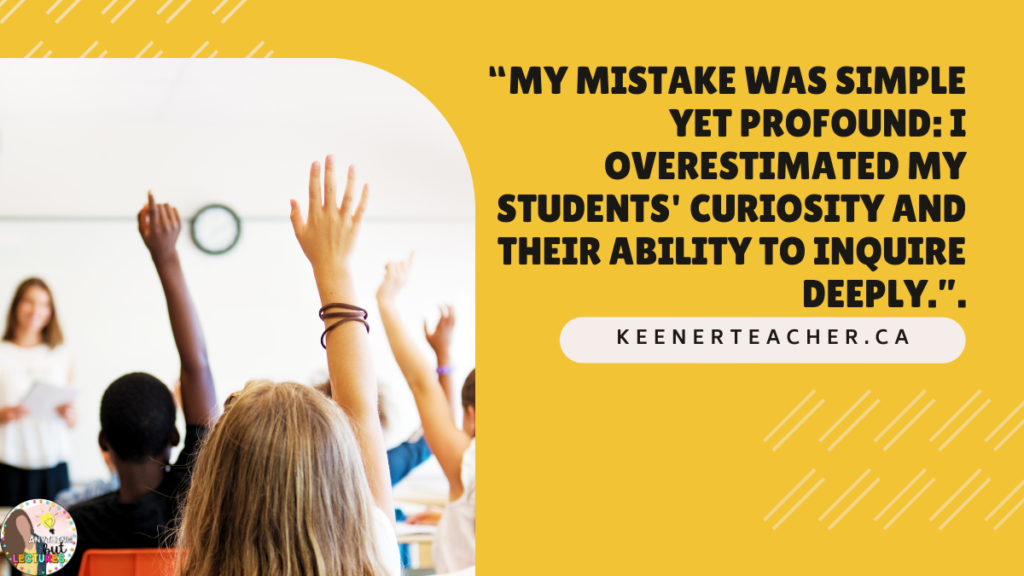Join me as I recount the number one mistake I made when first implementing the inquiry-based approach approach in my classroom, and how it led me to develop a transformative solution. I will share a free guide at the end!
Picture This:
A young, eager teacher planning what she believes to be a project for her students that will knock their socks off. She knows the students are going to be hooked from the minute this project starts. Why? This isn’t just your regular project. She has prepared provoking artifacts and simulations that will confuse, and therefore promote inquiry.

The Overestimation:
As a new teacher embracing the inquiry-based approach, I was bursting with excitement. I believed that by posing intriguing questions and presenting real-world problems, my students’ natural curiosity would ignite, propelling them into a world of self-driven discovery. But reality hit hard.
The Mistake:
My mistake was simple yet profound: I overestimated my students’ curiosity and their ability to inquire deeply. Instead of sparking a wildfire of interest, I was met with blank stares and disengagement. It became clear—I had misunderstood the essence of inquiry-based teaching.
The Revelation:
I realized that true inquiry-based learning is not just about asking questions; it’s about nurturing curiosity and teaching effective inquiry skills. This realization was a turning point. I knew I needed to rethink my approach if I wanted to truly engage my students.
What is the Inquiry-Based Approach?
The inquiry-based approach is a teaching method that places students at the center of the learning process.
Instead of the traditional teacher-centered approach where information is simply transmitted to students, the inquiry-based approach encourages students to ask questions, investigate problems, and develop solutions.
It’s about empowering students to become active participants in their learning journey, fostering critical thinking, creativity, and a deeper understanding of the subject matter.
The Solution to My Inquiry-Based Approach Issue:
Enter “The 10-day Curiosity Challenge for Educators”. This free guide was born from my own journey and is designed to help educators like you avoid the pitfalls I encountered. Each day, you’ll receive a new challenge that will empower you to create a classroom where curiosity thrives.

Take a Peek Inside the Challenge
In this guide, you will receive a one-page overview, which details the goal of the day. Some of the days’ goals may take more than one day to complete, however the purpose of keeping it to a 10-day challenge is to get the ball rolling!
After the overview, you will receive what you will need to accomplish that day’s task. This could be in the form of a checklist, planner template or cheat sheet.
Still need more details?
Here is exactly what you will be up to for the next 10 days:
Day 1 – Reflect on your teaching philosophy
Day 2 – Curiosity inventory
Day 3 – Provoking questions
Day 4 – Curiosity corner
Day 5 – Inquiry-based lesson
Day 6 – Guest speaker/field trip
Day 7 – Curiosity observation
Day 8 – curiosity-driven project
Day 9 – Curiosity walk
Day 10 – Curiosity cultivation plan
Why It Works:
The inquiry-based approach is about more than just asking questions; it’s about fostering a mindset of curiosity and exploration. By embracing this approach, you’ll not only develop critical thinking skills in your students but also ignite a lifelong passion for learning.
This challenge will give you the tools to make curiosity a priority in your planning. It will make planning for inquiry a habit in your lesson planning routine.

The Inquiry-Based Approach
Don’t make the same mistake I did. Sign up for “The 10-Day Curiosity Challenge for Educators” and join me in inspiring curiosity and empowering students to inquire about the world around them. Let’s turn missteps into mastery and create a future where learning knows no bounds.
Check out these related blog posts:



